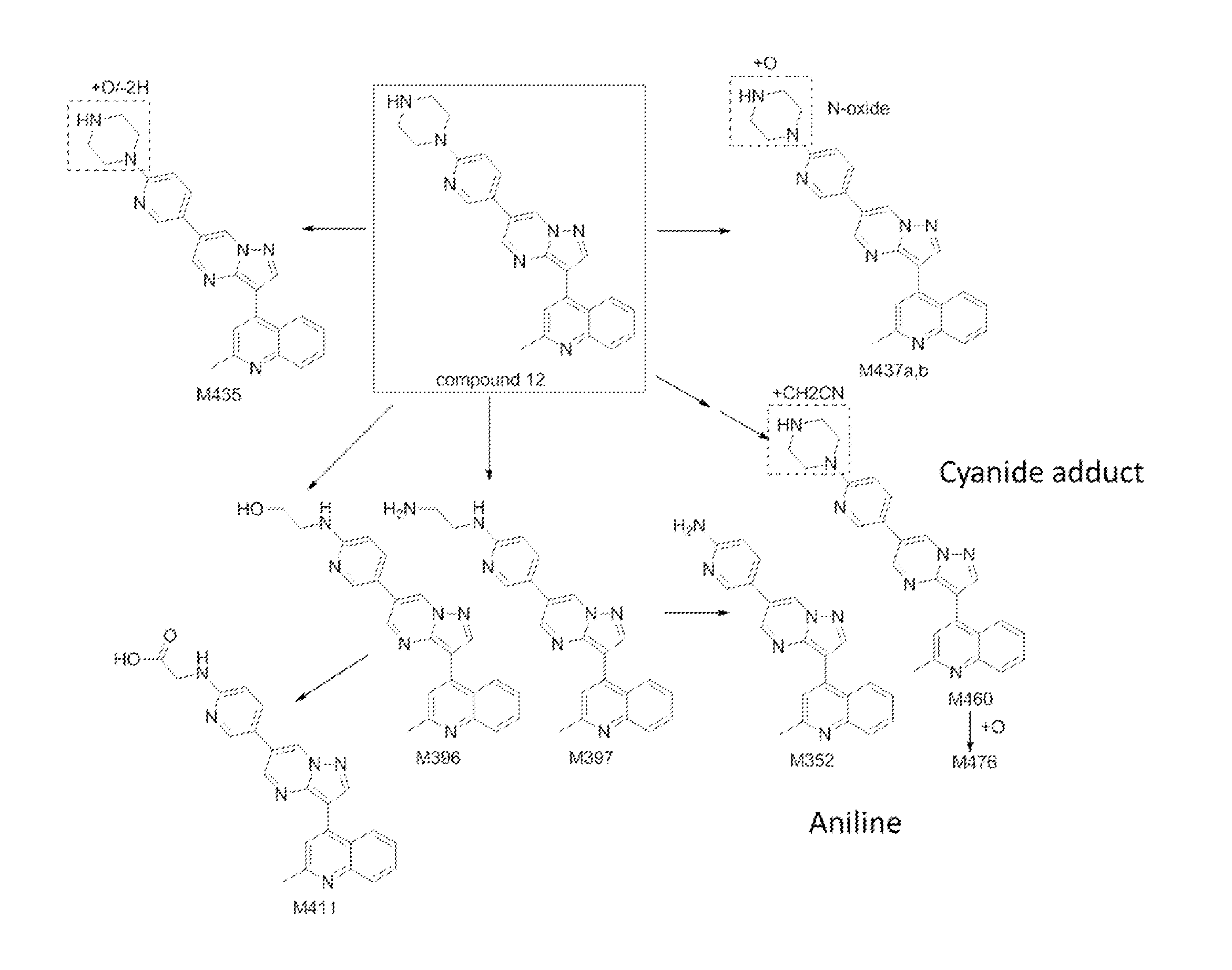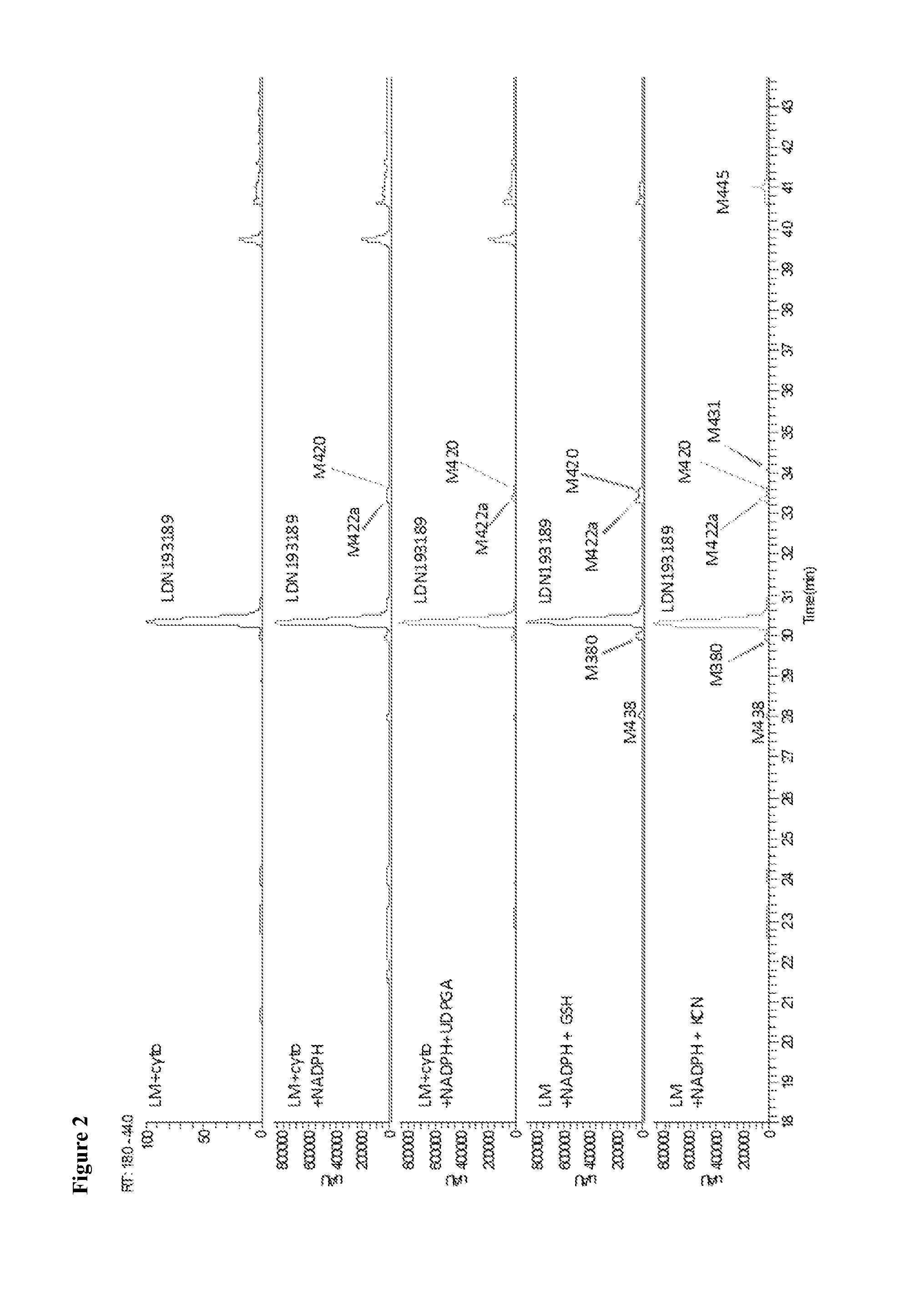Bmp inhibitors and methods of use thereof
a technology of bmp and inhibitors, which is applied in the field of bmp inhibitors, can solve the problems of limited specificity of endogenous inhibitors such as noggin and follistatin for ligand subclasses, ineffective and practical methods for inhibiting bmp signals via soluble receptors, and limited structural diversity of this signaling system, so as to reduce the circulating levels of apob-100 and/or ldl and/or total cholesterol,
- Summary
- Abstract
- Description
- Claims
- Application Information
AI Technical Summary
Benefits of technology
Problems solved by technology
Method used
Image
Examples
example 1
Synthetic Protocols
Compound 1
[0321]
[0322]To a suspension of 4-(6-bromopyrazolo[1,5-a]pyrimidin-3-yl)quinoline (0.325 g, 0.999 mmol) (WO2009 / 114180 A1, 2009) and tert-butyl 4-(5-(4,4,5,5-tetramethyl-1,3,2-dioxaborolan-2-yl)pyridin-2-yl)piperazine-1-carboxylate (0.584 g, 1.499 mmol) in dioxane degassed with N2 was added Pd(PPh3)4 (0.058 g, 0.050 mmol) then aqueous sodium carbonate (2 M, 1.5 mL). The mixture was heated to reflux for 1.7 h. The mixture was partitioned between EtOAc (30 mL) and water (30 mL). The organic layer was washed with brine, dried (Na2SO4), filtered and concentrated. Triturated crude material with EtOH, filtered and washed solid with EtOH. Obtained tert-butyl 4-(5-(3-(quinolin-4-yl)pyrazolo[1,5-a]pyrimidin-6-yl)pyridin-2-yl)piperazine-1-carboxylate (0.22 g, 0.433 mmol, 43.4% yield) as a yellow solid.
[0323]Dissolved tert-butyl 4-(5-(3-(quinolin-4-yl)pyrazolo[1,5-a]pyrimidin-6-yl)pyridin-2-yl)piperazine-1-carboxylate (0.20 g, 0.394 mmol) in TFA (3 mL) and stirred a...
example 2
Enzyme Assays
[0608]Compounds were assessed in ALK1-6 enzymatic assays. Specifically, compounds were assayed using LANCE® Ultra ULight™ technology (Perkin Elmer) against human ALK1-6 enzymes (ALK1: Life Technologies, ALK2-6: Carna Biosciences). Briefly, ALK enzyme (10 nM) was prepared in kinase buffer (50 mM HEPES, pH 7.5, 10 mM MgCl2, 3 mM MgCl2, 0.005% Tween-20 and 2 mM DTT) and dispensed at 2.5 μL / well into a 1536 well, white, solid bottom, microtiter plate (Greiner, 789175-F). Negative controls for the assay were generated by adding one column containing kinase buffer only. Compounds in DMSO solution were transferred to the assay plates at 23 nL / well via a NX-TR pin tool workstation (WAKO, San Diego, Calif.) and incubated with enzyme for 10 minutes at ambient temperature. ULight Topo IIa Substrate (50 nM) was prepared in kinase buffer containing either 10 μM or 1000 μM ATP and dispensed at 2.5 μL / well into the assay plate. Following a 1 hour incubation at ambient temperature, Eur...
example 3
[0610]C2C12 myofibroblasts cells stably transfected with BMP responsive element from the Id1 promoter fused to luciferase reporter gene (BRE-Luc) and human embryonic kidney 293T cells stably transfected with the TGF-β responsive element from the PAI-1 promoter fused to luciferase reporter gene (CAGA-Luc) were cultured in DMEM (Life Technologies) supplemented with 10% FBS, L-glutamine, and pen / strep at 37° C. and 10% CO2. C2C12 Bre-Luc and 293T CAGA-Luc cells were seeded at 20,000 cells in 80 μL DMEM supplemented with 2% FBS per well in tissue culture treated 96-well plates (Costar® 3610; Corning). The cells were incubated for 1 hour at 37° C. and 10% CO2 and allowed to settle and attach. The compounds of interest were diluted in DMEM at 10-fold the final concentrations ranging from 1 to 100 μM and added in 10 μL aliquots. Positive controls were generated by replacing the compound aliquot with just 10 μL of DMEM. The cells were then incubated for 30 min at 37° C....
PUM
| Property | Measurement | Unit |
|---|---|---|
| Expansion enthalpy | aaaaa | aaaaa |
Abstract
Description
Claims
Application Information
 Login to View More
Login to View More - R&D
- Intellectual Property
- Life Sciences
- Materials
- Tech Scout
- Unparalleled Data Quality
- Higher Quality Content
- 60% Fewer Hallucinations
Browse by: Latest US Patents, China's latest patents, Technical Efficacy Thesaurus, Application Domain, Technology Topic, Popular Technical Reports.
© 2025 PatSnap. All rights reserved.Legal|Privacy policy|Modern Slavery Act Transparency Statement|Sitemap|About US| Contact US: help@patsnap.com



